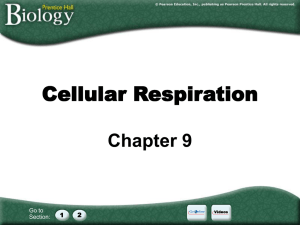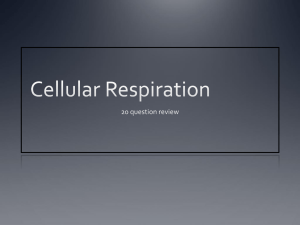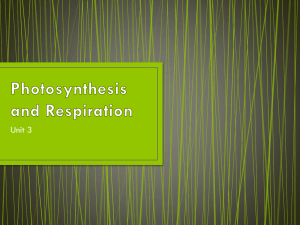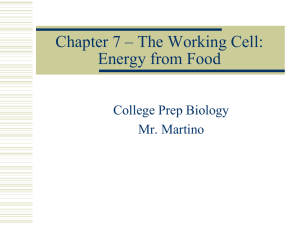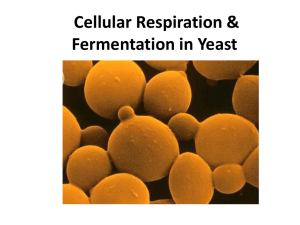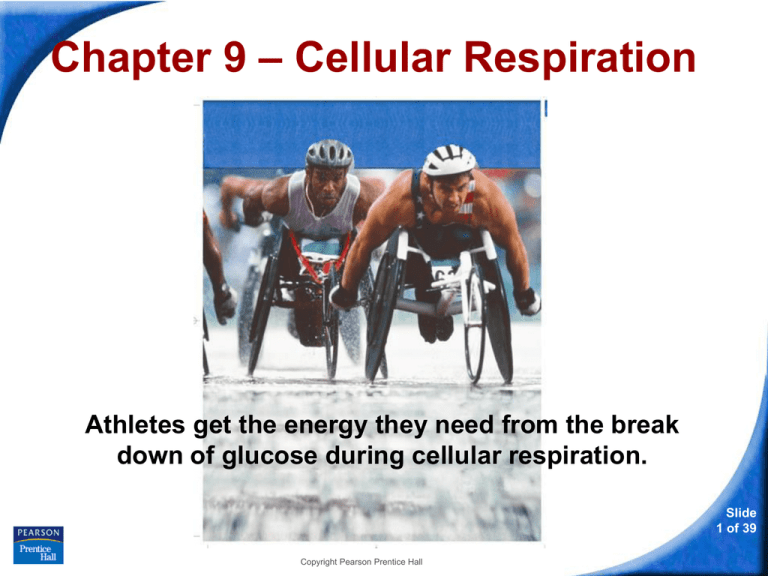
Chapter 9 – Cellular Respiration
Athletes get the energy they need from the break
down of glucose during cellular respiration.
Slide
1 of 39
Copyright Pearson Prentice Hall
9-1 Chemical Pathways
What types of cells does CR take
place in?
Cellular respiration takes place in both ANIMAL
and PLANT cells.
Animal Cells
Animal
Mitochondrion
Plant
Plant Cells
Copyright Pearson Prentice Hall
Slide
2 of 39
9-1 Chemical Pathways What organelle doe CR take place in?
The MITOCHONDRIA is where cellular respiration takes place.
Outer membrane
Intermembrane
space
Inner
membrane
Mitochondrion
Matrix
Slide
3 of 39
Copyright Pearson Prentice Hall
9-1 Chemical Pathways
Key Facts about Cellular Respiration
1. Food is required.
2. The food is GLUCOSE (C6H12O6).
3. Glucose is broken down into ENERGY.
4. The energy made is in the form of ATP.
Slide
4 of 39
Copyright Pearson Prentice Hall
9-1 Chemical Pathways
The equation for cellular respiration is:
6O2 + C6H12O6 → 6CO2 + 6H2O + Energy
oxygen + glucose → carbon dioxide + water + energy
(ATP)
What are the reactants? ___________ and __________
What are the products? _________ and ________ and
Slide
____________
5 of 39
Copyright Pearson Prentice Hall
9-1 Chemical Pathways
Overview of Cellular Respiration
What is cellular respiration?
Cellular respiration is the process that
releases energy by breaking down glucose
and other food molecules in the presence of
oxygen.
Slide
6 of 39
Copyright Pearson Prentice Hall
9-1 Chemical Pathways
Cellular Respiration has 3 parts:
1.Glycolysis
2.Kreb Cycle (Citric Acid Cycle)
3. Electron Transport Chain (ETC)
Slide
7 of 39
Copyright Pearson Prentice Hall
9-1 Chemical Pathways
Overview of Cellular Respiration
Electrons carried in NADH
Electrons carried
in NADH and
FADH2
Pyruvic
acid
Glucose
Glycolysis
Cytoplasm
Mitochondrion
Slide
8 of 39
Copyright Pearson Prentice Hall
Anaerobic vs. Aerobic
ANAEROBIC - no oxygen required
•GLYCOLYSIS
AEROBIC - oxygen required
•CITRIC ACID CYCLE
•ELECTRON TRANSPORT CHAIN
Slide
9 of 39
Copyright Pearson Prentice Hall
Glycolysis (part 1)
Where does it take place?
What is it?
cytoplasm of cell
(outside of mitochondria)
A series of chemical reactions
that break down glucose
How?
Breaks down glucose through chemical
reactions
Why?
To make 2 molecules of pyruvic acid and 2
molecules of ATP
Does it require oxygen? NO – it’s anaerobic
Copyright Pearson Prentice Hall
Slide
10 of 39
9-1 Chemical Pathways
Glycolysis
ATP Production
At the beginning of glycolysis, the cell uses up 2
molecules of ATP to start the reaction.
2 ATP
2 ADP
4 ADP
4 ATP
Glucose
2 Pyruvic
acid
Slide
11 of 39
Copyright Pearson Prentice Hall
9-1 Chemical Pathways
Glycolysis
When glycolysis is complete, 4 ATP molecules
have been produced.
2 ATP
2 ADP
4 ADP
4 ATP
Glucose
2 Pyruvic
acid
Slide
12 of 39
Copyright Pearson Prentice Hall
9-1 Chemical Pathways
Glycolysis
This gives the cell a net gain of 2 ATP molecules.
2 ATP
2 ADP
4 ADP
4 ATP
Glucose
2 Pyruvic
acid
Slide
13 of 39
Copyright Pearson Prentice Hall
Kreb Cycle (Citric Acid Cycle)
Where does it take place?
What is it?
[Part 2]
Mitochondria (inner matrix)
A series of chemical reactions
that breaks down pyruvic acid
How?
Pyruvic acid is changed into acetyl-CoA then
to Citric Acid -then to other carbon compounds
Why?
Makes Carbon Dioxide and 2 ATP
Does it require oxygen? YES – it’s aerobic!
Slide
14 of 39
Copyright Pearson Prentice Hall
The Krebs cycle
begins when pyruvic
acid produced by
glycolysis enters the
mitochondrion.
Slide
15 of 39
Copyright Pearson Prentice Hall
Slide
16 of 39
9-1 Chemical Pathways
Electron Transport Chain (ETC) [Part 3]
Where?
Mitochondria (inner membrane)
What?
Energized electrons move from
protein to protein located in the
inner membrane of mitochodria
How?
NADH and FADH2 give up
electrons
Why?
To make 34 ATP!!!
Does it require oxygen? YES – it’s aerobic!
Slide
17 of 39
Copyright Pearson Prentice Hall
9-1 Chemical Pathways
Electron Transport
High-energy electrons from NADH and FADH2 are
passed along the electron transport chain from one
carrier protein to the next.
Slide
18 of 39
Copyright Pearson Prentice Hall
9-1 Chemical Pathways
Electron Transport
As it rotates, the enzyme grabs a low-energy ADP,
attaching a phosphate, forming high-energy ATP.
Channel
ATP
synthase
ATP
Slide
19 of 39
Copyright Pearson Prentice Hall
9-1 Chemical Pathways
Fermentation
Fermentation
What happens when oxygen is not present?
Fermentation takes place after gylcolysis.
NO KREB CYCLE OR ETC!!!!
Fermentation releases energy from food
molecules by producing ATP in the absence of
oxygen.
Slide
20 of 39
Copyright Pearson Prentice Hall
9-1 Chemical Pathways
Fermentation
What are the two main types of
fermentation?
1. Lactic Acid Fermentation
2. Alcoholic Fermentation
Slide
21 of 39
Copyright Pearson Prentice Hall
FERMENTATION
When?
When cells are short on oxygen
What?
Anaerobic process that follows
glycolysis until oxygen is
available.
How?
Lactic Acid Fermentation or
Alcoholic Fermentation
Why?
To produce energy when oxygen
is low
Requires Oxygen?
No- it’s anaerobic!
Copyright Pearson
Slide
22 of 39
FERMENTATION
LACTIC ACID
ALCOHOLIC
Glucose
Glucose
Pyruvic Acid
Pyruvic Acid
Lactic Acid + 2ATP
Alcohol + 2ATP + CO2
Occurs in bacteria,
plants, and animals
Yeast
Muscle fatigue
Copyright Pearson
Prentice Hall
Slide
23 of 39
9-1
Click to Launch:
Continue to:
- or -
Slide
24 of 39
Copyright Pearson Prentice Hall
9-1
The raw materials required for cellular
respiration are
a. carbon dioxide and oxygen.
b. glucose and water.
c. glucose and oxygen.
d. carbon dioxide and water.
Slide
25 of 39
Copyright Pearson Prentice Hall
9-1
Glycolysis occurs in the
a. mitochondria.
b. cytoplasm.
c. nucleus.
d. chloroplasts.
Slide
26 of 39
Copyright Pearson Prentice Hall
9-1
The net gain of ATP molecules after glycolysis is
a. 3 ATP molecules.
b. 2 ATP molecules.
c. 3 pyruvic acid molecules.
d. 4 pyruvic acid molecules.
Slide
27 of 39
Copyright Pearson Prentice Hall
9-1
Fermentation releases energy from food
molecules in the absence of
a. oxygen.
b. glucose.
c. NADH.
d. alcohol.
Slide
28 of 39
Copyright Pearson Prentice Hall
9-1
The first step in fermentation is always
a. lactic acid production.
b. the Krebs cycle.
c. glycolysis.
d. alcohol production.
Slide
29 of 39
Copyright Pearson Prentice Hall

